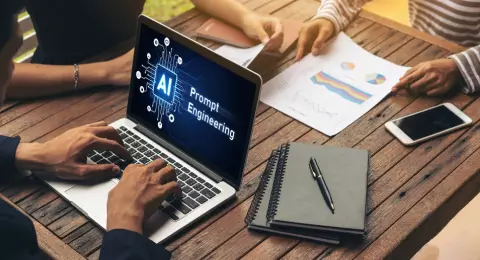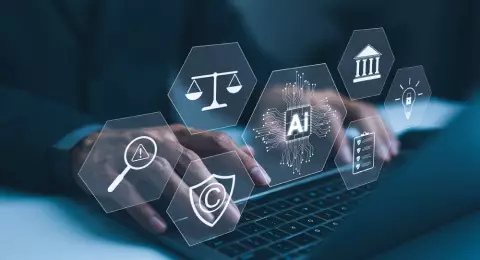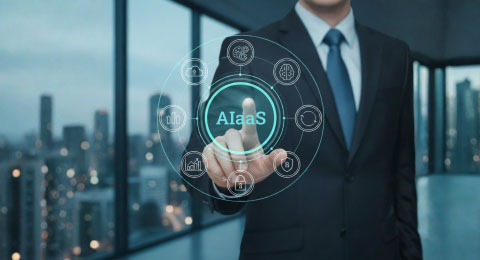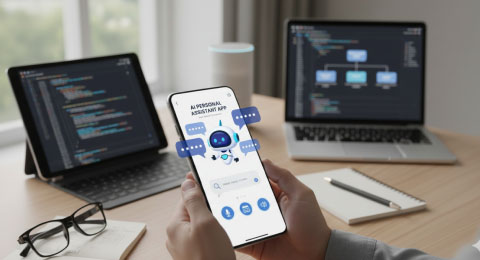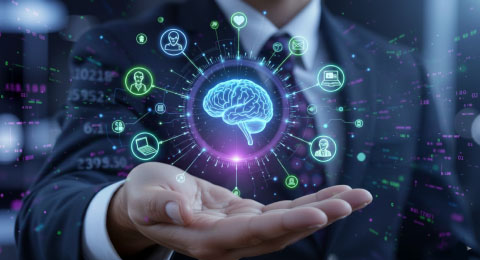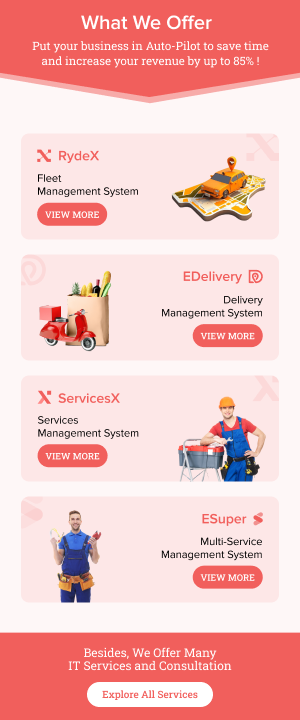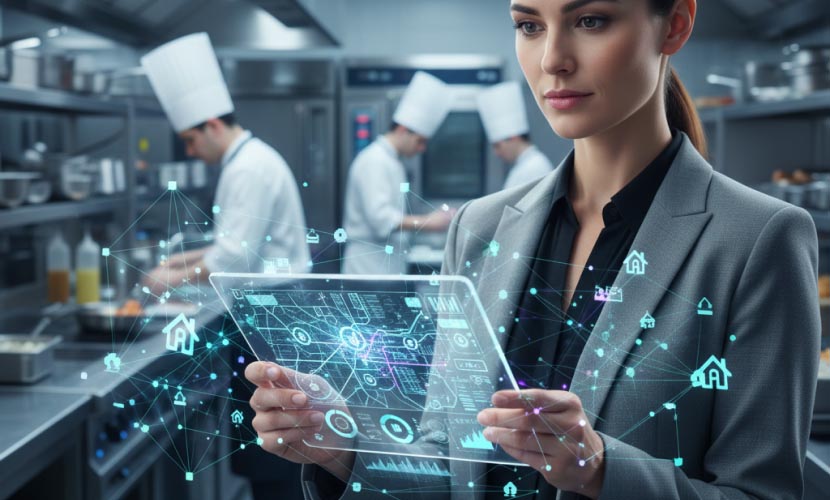
AI can power your food delivery business for faster deliveries, better inventory planning, smart pricing, and improved customer support. However, most entrepreneurs do not know how to use it to stay competitive.
- What is the Role of AI in Food Delivery App?
- Key AI Features in Food Delivery App
- Benefits of AI in Food Delivery App
- Future Trends of AI in Food Delivery App
- Conclusion
- FAQs
If you are one of them, this article will help you learn the benefits of using AI in food delivery app. You will also understand which AI trends to integrate for long-term growth.
Let’s imagine a customer places an order on your food delivery app. The food is ready on time. But the deliveryman gets stuck in traffic. The customer waits longer than promised. When the food finally arrives, it is cold. The customer leaves a poor rating and never comes back.
This may feel small, but such misfortunes impact the bottom line. Fortunately, by integrating AI-powered route optimization in food delivery app, you can solve these problems before they grow.
We have more features, benefits, and roles to discuss about AI, which can improve and enhance your food delivery app and business operations. Let’s explore them thoroughly.
What is the Role of AI in Food Delivery App?
Food delivery is simple for customers but tough for businesses. Among other factors, long wait times, wrong orders, and price issues hurt user trust the most. Luckily, with advanced AI features in food delivery app, you can bypass these issues with automation.
AI for Operational Efficiency and Automation
AI can forecast demand so you can prepare the right amount of food to prevent waste and stock-outs. Also, AI inventory tools can track supplies and reorder automatically. This keeps kitchens running without interruptions.
Restaurants often struggle with staff shortages and changing demand. By using AI in your food delivery app, you can automate numerous repetitive tasks in restaurant POS systems, like receiving orders and updating inventory, to overcome staff shortages. Additionally, AI-powered smart pricing models can adjust menu prices based on demand. Customers see fair rates, and restaurants earn better margins.
AI for Real-time Decision-making and Customer Support
The benefits of AI features in food delivery app also extend to automatic route planning in real-time. Your deliveryman takes optimized routes and completes more orders, saving you both fuel and time.
During peak hours, restaurants face challenges in resolving customer issues while maintaining a short waiting time. AI chatbots can solve this issue. They answer queries fast and offer solutions in real time. NLP further allows them to understand customer tone and intent. This improves support and lowers staff stress.
By solving these pressing challenges, AI makes the food delivery business a profitable model for customers and restaurants alike.
Key AI Features in Food Delivery App
The challenge is not to use AI but to choose the right AI features in food delivery app. This section covers the most useful ones that can transform how your app performs.
AI-powered Chatbots and Virtual Agents
Nearly 40% of consumers cancel a purchase or switch to alternatives when they cannot reach support quickly. It also often leads to negative reviews.
AI-powered chatbots and virtual agents solve this problem. They instantly respond to customer queries by using NLP to understand customer sentiments well. Customers receive almost instant responses to simple queries like order status, refund requests, and delivery time.
Things to Keep in Mind:
- Chatbots and virtual agents should be trained with ample real-time data to not sound robotic or confusing during conversations.
- Data should be updated frequently to reflect menu changes, delivery policies, or new offers.
- Always provide an option to switch to a human when needed.
Smart Route Optimization and Delivery Scheduling
In big cities, food delivery businesses often face challenges in meeting on-time deliveries. As per a survey report, about 66% of survey respondents said they would stop ordering from a delivery app after a late delivery.
This can be avoided with AI-powered smart route optimization. Here, AI analyzes real-time traffic, weather, and delivery density to suggest the best route for faster delivery. It also helps your deliverymen schedule multiple orders on the same route. That means more earnings for them and efficiency for you.
Things to Keep in Mind:
- AI models should adapt quickly to traffic and weather conditions.
- The system should not make deliverymen feel overworked or force them into risky routes due to algorithmic inefficiency.
This is one of the important AI features in the food delivery app, if you want consistent and reliable performance.
AI-driven Demand Forecasting and Inventory Management
Do you know that an average restaurant wastes between 4%-10% of all food inventory they purchase? It happens because they cannot predict demand accurately. Too much food gets wasted, or customers hear “item not available.”
You can avoid these issues by integrating AI-powered demand forecasting and inventory management features into your app.
These systems analyze past orders and forecast restaurant business trends according to upcoming local events. They predict what dishes will sell and in what quantity. With this insight, you stock just the right amount of ingredients. You also reduce storage costs and keep the kitchen running smoothly. Real-time tracking alerts you when supplies are low. Automatic reorders ensure you never miss a sale.
Things to Keep in Mind:
- Forecasting accuracy improves by feeding the system with reliable order history.
- Small restaurants may start with limited data, so patience is important.
- Initial resistance from the team to trust and follow the system can delay results.
Done well, AI forecasting makes your app stay reliable, even during peak demands.
Personalized Recommendations with NLP and LLMs
According to one of the recent food delivery statistics, nearly 55% of customers ordering food online belong to the Gen Z group. They want to quickly order some food, but now they feel lost when browsing long menus.
It is most likely that they will abandon the order if choices feel overwhelming. As a result, you lose sales.
Personalized recommendations solve this. AI uses natural language processing and large language models to understand preferences. It studies past orders of your customers, time of day, and even customer reviews. Based on this, the app suggests meals you are likely to enjoy. It also highlights sides or drinks that match your order. This makes browsing easier and ordering faster. For restaurants, it increases order value without aggressive upselling.
Things to Keep in Mind:
- Personalization should not make customers feel like being tracked too closely.
- Be transparent about how data is used.
- Allow users to control preferences and opt out if they want.
Computer Vision for Verification and Safety
Security is a growing concern in food delivery. Customers worry about sharing their personal information, while restaurants fear tampered orders. Deliverymen also face issues with account misuse or false claims. These problems reduce trust and can harm your brand.
Computer vision addresses these concerns. With facial recognition, food delivery companies can verify deliverymen before they accept or deliver an order. This ensures only authorized people handle the food. Cameras can also check packaging quality to confirm it is sealed properly. In some cases, AI can spot unsafe food conditions, like spillage or damaged boxes, before delivery. These checks make customers feel secure and cared for.
Things to Keep in Mind:
- Always ask for consent before collecting biometric data.
- Be clear about how the information will be used and stored.
- Also, invest in systems that are accurate. False rejections frustrate deliverymen and cause delays.
Automated Reports and Smart Pricing Models
Your business analytics can yield valuable insights for strategy management. However, without automated systems, managing large volumes of data takes hours and increases the risk of human error. Even a small error can distort insights and prompt you to make bad decisions.
In this regard, AI-powered automated reporting systems are super helpful. They analyze performance data in real time and project it through different metrics on the dashboard. Now, you can clearly see delivery speed, customer feedback, and sales trends on a single screen.
AI offers you the leverage to introduce smart pricing models. They adjust rates based on demand, time, and location. Customers see fair prices, while restaurants and delivery partners maximize earnings.
Things to Keep in Mind:
- Smart pricing must stay transparent.
- Sudden price spikes frustrate customers.
- Clearly explain how dynamic pricing works.
- For reports, focus on usability.
- Complex dashboards overwhelm users who just want simple answers.
Leverage Our Expertise to Use AI in Your Food Delivery App for Sustainable Growth Over Time
Benefits of AI in Food Delivery App
According to research published on ResearchGate, AI-based routing software can reduce operational costs up to 15%. However, the benefits of AI in the food delivery app go far beyond routing, such as:
Faster Delivery and Lower Costs
- Smart routing finds the quickest paths to save you more on fuel and transportation costs.
- AI helps restaurants plan deliveries more efficiently so orders arrive fresh and on time.
Predictive Planning for Reduced Waste
- With predictive analysis, your restaurant avoids waste and overstock.
- It prevents overstock and waste by tracking demand patterns and order frequency.
Better Customer Experience
- As chatbots respond instantly to order issues, queries are solved without long waits.
- Customers feel understood when AI-powered menu suggestions match their taste.
Improved Operations and Accuracy
- Inventory tools track ingredients automatically to avoid shortages.
- AI-powered order management reduces the chances of errors in orders and ensures customers get the right delivery, fresh and on time.
Smarter Pricing and Insight
- Dynamic pricing adjusts cost based on demand to get you fair deals.
- AI analytics also help restaurants understand buying patterns and adjust prices to stay competitive.
Automated Reporting for Better Decisions
- Managers leverage auto-reports to spot problems early to ensure steady operations.
- These insights make it easier to detect problems early and maintain smooth operations.
Trust and Safety Gains
- Features, like facial recognition, empower customers to verify delivery agents. Along with other generic food delivery app features, AI adds an extra layer of security to make your restaurant a customer-favourite brand in the market.
- AI systems automatically flag fraud or misuse for further peace of mind.
Future Trends of AI in Food Delivery App
The role of AI in the food and beverages market is going to be valued at USD 67.73 billion by 2030. So, what should you expect of AI for your food delivery business?
Let’s take a quick look at some probable future trends that are going to change the fate of the food delivery business forever.
Autonomous Delivery and Robotics
Robots and drones will slowly become a new norm to deliver food to your customers. That’s because AI is evolving faster to be good at autonomous navigation, obstacle avoidance, and efficient route optimization. This can reduce human errors and speed up delivery.
Hyper-personalized Experiences
Future food delivery mobile app will learn the eating patterns of your customers and suggest meals even before they search. Recommendations will feel natural and relevant. It will also help you offer customized discounts and offers to match your customers’ purchase history.
Generative Content and Menu Innovation
Generative AI LLMs are improving faster. The future may see AI creating food photos, writing menu descriptions, and even designing offers to match your customers’ mood or location. As a result, menus will feel more engaging and less generic.
Conclusion
The F&B industry is evolving in proportion to the dynamic preferences of customers from time to time. Anyone trying to thrive in a food delivery business should expect a rise in demand for faster service, smart pricing, and personalized support.
That said, this is the perfect time to adopt AI in food delivery app. AI can solve inventory issues, speed up deliveries, and improve customer trust. You can also leverage its power to bypass repetitive tasks and help your staff focus on customer experience.
If you wait too long to adopt AI, you risk losing ground to rivals.
All you need is the right partner to leverage the benefits of AI in a food delivery app. An experienced AI development company can suggest the right tools and strategies to scale quickly without costly mistakes.
Use AI features in your food delivery app and have a competitive edge in the market before it’s too late.
FAQs
Food delivery app use several AI technologies to work smarter. For example, machine learning and predictive analytics predict busy hours, track order trends and top-selling dishes. Similarly, NLP helps chatbots interact with customers, while computer vision adds safety by verifying deliverymen through facial recognition.
Yes, you can add AI features in food delivery app already built before through APIs or modular systems. For example, you can integrate a third-party route optimization API for dynamic rerouting to improve delivery speed.
Yes, the benefits of AI features in food delivery app also extend to analyzing traffic in real-time. AI can present faster delivery routes through smart mapping. This reduces the chances of wrong deliveries and minimizes delays. Ultimately, it will lead to fewer refund requests.
AI can reduce staff dependency for handling repetitive tasks, like taking reservations or entering orders into the POS. You can also leverage smart chatbots and predictive tools to aid staff in meeting higher customer service standards.


